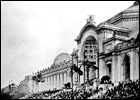![]()
![]()
![]()
![]()
![]()
![]()
Berkeley's Past,
And Past Dreams Of the Future
Museum Exhibits Rarely Seen Materials from 1896 Master Plan Competition
Posted December 1, 1999
|
|
|
The show -- running Dec. 15 through April 23 -- provides a rare view into the past, and past dreams of the future, for the campus. It features stunning large-scale drawings, preliminary designs of buildings and setting of the campus, as well as related photographs. Much of this material has remained unseen for the past 100 years.
In 1895, at the suggestion of acclaimed Berkeley architect Bernard Maybeck, mining and real estate heiress Phoebe Apperson Hearst agreed to sponsor an international architectural competition to select a master plan for the Berkeley campus. Along with the university regents, Hearst envisioned UC Berkeley as a classical "city beautiful" on the Pacific rim of the Western world.
The international competition began amid much publicity and attracted worldwide interest. More than 100 entries were received for the preliminary round of judging, held at the Royal Museum of Fine Arts in Antwerp, Belgium. From this group, eleven finalists -- five from Europe and six from the East Coast -- were invited to submit revised entries for judging in San Francisco in 1899.
First prize, which included a $10,000 award, went to French architect Emil Bénard whose entry featured buildings in the Franco-Roman style and arranged around grand public squares. Because of conflicts with Hearst and the UC regents, Benard was soon replaced by New York architect John Galen Howard, hired in 1901 to realize a modified version of Bénard's scheme.
In the 1920s, Phoebe Hearst's son, William Randolph, commissioned Bernard Maybeck to design a series of campus buildings as a memorial to his mother. Of these, only the Phoebe Hearst Women's Gymnasium, designed by Maybeck and Julia Morgan, was realized. The exhibition includes materials from these designs.
"Roma/Pacifica" was curated by Berkeley alumnus Robert Judson Clark, professor emeritus of art and archeology at Princeton University, with assistance of alumnus Gray Brechin, a specialist in California history, environment and architecture.
Most of the material on display comes from the collection of the Environmental Design Archives, with additional materials from the University Archive and the Bancroft Library.
For information see the museum Web site at www.bampfa.berkeley.edu or call 642-0808 for 24-hour recorded museum information.
Public Programs
Thursday, Dec. 9, 12:15 p.m.; Sunday, Jan. 23, 3
p.m.; and Thursday, Feb. 24, 12:15 p.m.
Gray Brechin, who played an instrumental role in the
conception of the exhibit, will offer three walk-throughs of
the exhibition. Brechin will explore, among other topics,
the larger context for the competition, that of U.S.
expansion in the Pacific.
Sunday, Feb. 6, 3 p.m.
Guest curator Robert Judson Clark will lecture on themes
from the exhibition and on what the architectural drawings
and buildings up to 1930 reveal about the evolving idea of a
"university in the wilderness."
Sunday, Feb. 27, 3 p.m.
David Van Zanten will lecture on principles of
monumental design, especially as American architects
understood them to have been formulated at the École
de Beaux-Arts in Paris. Van Zanten is professor of art
history at Northwestern University.
![]()
![]()
December 1, 1999 -
January 11, 2000 (Volume 28, Number 16)
Copyright 1999, The Regents of the University of
California.
Produced and maintained by the Office
of Public Affairs
at UC
Berkeley.
Comments? E-mail berkeleyan@pa.urel.berkeley.edu.
